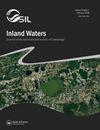评估内部负荷管理控制Rauwbraken湖富营养化的长期效果
IF 2.3
3区 环境科学与生态学
Q1 LIMNOLOGY
引用次数: 9
摘要
Rauwbraken湖受到外源磷(P)扩散负荷引起的富营养化影响(2008年估计总磷荷载为1.21 mg m−2 d−1)。40多年来,这种负荷在沉积物中形成了一个遗留池,导致6.82 mg m−2 d−1 PO4-P内部负荷(2008年估计),导致蓝藻繁殖和游泳禁令。为了解决该湖泊的内部负荷,2008年应用了低剂量絮凝剂(聚氯化铝)与固相磷酸盐固定剂(镧改性膨润土)的组合处理。我们研究了这种处理的化学和生态反应,以证明在不减少外部负荷的情况下控制内部负荷的有效性。根据处理前2年和处理后10年的监测,平均Secchi盘深度(3.5 ~ 4.0 m)和低氧浓度(0.86 ~ 4.55 mg L−1)增加,浊度(5.4 ~ 2.2 NTU)、叶绿素 a(16.5 ~ 5.5µg L−1)、蓝藻贡献(64% ~ 17%的叶绿素a)、总磷(134 ~ 14µg L−1)和总氮(0.96 ~ 0.50 mg L−1)减少。该处理使缺氧条件下沉积物的PO4-P释放量从2008年的15.1降至1.7 mg m−2 d−1,2011年降至2.3 mg m−2 d−1,2013年降至4.7 mg m−2 d−1。处理后,淹没植物在2008年和2009年达到较高的覆盖率。长期来看,处理后的大型植物覆盖减少。在控制内部负荷10年后,由于持续的外部磷负荷,湖泊正在恢复到富营养化状态。本文章由计算机程序翻译,如有差异,请以英文原文为准。
Assessing the long-term efficacy of internal loading management to control eutrophication in Lake Rauwbraken
ABSTRACT Lake Rauwbraken was impacted by eutrophication caused by diffuse external phosphorus (P) loads (total 1.21 mg m−2 d−1, estimated in 2008). Over 40 years, this load built up a legacy pool in the sediments, resulting in 6.82 mg m−2 d−1 PO4-P internal load (estimated in 2008), causing cyanobacterial blooms and swimming bans. To address the internal load in this lake, a low dose treatment of flocculant (polyaluminium chloride) combined with a solid phase phosphate fixative (lanthanum-modified bentonite) was applied in 2008. We examined the chemical and ecological responses to this treatment to demonstrate the efficacy of controlling internal loading without reducing external loading. Based on 2 years pre- and 10 years post-treatment monitoring, the mean Secchi disk depth (3.5–4.0 m) and the hypolimnetic oxygen concentration (0.86–4.55 mg L−1) increased while decreases occurred in turbidity (5.4 to 2.2 NTU), chlorophyll a (16.5 to 5.5 µg L−1), contribution of cyanobacteria (64% to 17% of chlorophyll a), total phosphorus (134 to 14 µg L−1), and total nitrogen (0.96 to 0.50 mg L−1). The treatment reduced the PO4-P release from sediment under anoxic conditions from 15.1 to 1.7 mg m−2 d−1 post-treatment in 2008, 2.3 mg m−2 d−1 in 2011, and 4.7 mg m−2 d−1 in 2013. Post-treatment, submerged macrophytes reached high coverage in 2008 and 2009. Longer term, post-treatment macrophyte cover was reduced. The lake is returning to a eutrophic state as a result of ongoing external P loads 10 years following the control of internal loading.
求助全文
通过发布文献求助,成功后即可免费获取论文全文。
去求助
来源期刊

Inland Waters
LIMNOLOGY-MARINE & FRESHWATER BIOLOGY
CiteScore
6.10
自引率
9.70%
发文量
34
审稿时长
>12 weeks
期刊介绍:
Inland Waters is the peer-reviewed, scholarly outlet for original papers that advance science within the framework of the International Society of Limnology (SIL). The journal promotes understanding of inland aquatic ecosystems and their management. Subject matter parallels the content of SIL Congresses, and submissions based on presentations are encouraged.
All aspects of physical, chemical, and biological limnology are appropriate, as are papers on applied and regional limnology. The journal also aims to publish articles resulting from plenary lectures presented at SIL Congresses and occasional synthesis articles, as well as issues dedicated to a particular theme, specific water body, or aquatic ecosystem in a geographical area. Publication in the journal is not restricted to SIL members.
 求助内容:
求助内容: 应助结果提醒方式:
应助结果提醒方式:


